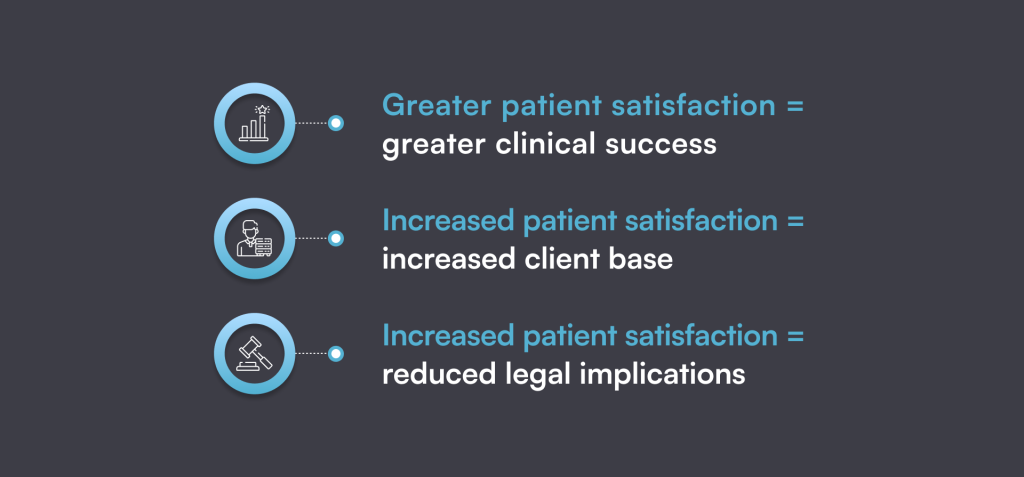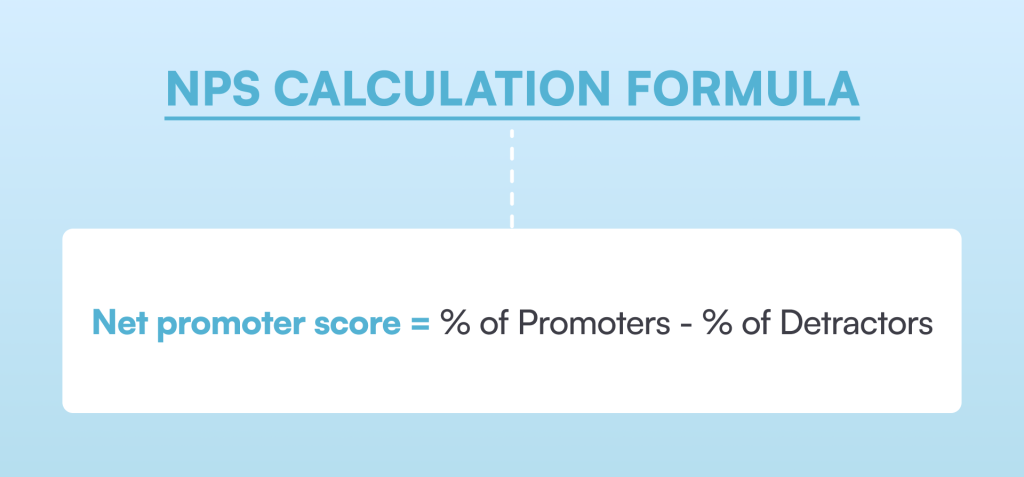If you’re aiming for a steady revenue flow, a base of loyal returning clients, and a position of excellence among your competitors, then a key priority should be patient satisfaction.
Providing exceptional medical care is non-negotiable, but nowadays, that’s not enough.
Keeping pace with increasing patient expectations can be challenging, but there are key metrics that can help you separate reasonable expectations from unattainable ones. This will aid you in enhancing your services and approaches to meet and exceed these expectations.
We’re here to help, so let’s explore together the key metrics you need to track to measure patient satisfaction in your clinic.
The significance of patient satisfaction in healthcare
“Before patients start caring about what you know, they have to know that you care.”
So goes the expression. What patients think about your clinic is the foundation that orchestrates everything else and, ultimately, determines the success of your business.
Patient satisfaction has a significant impact on the clinic’s reputation, patient retention, overall healthcare experiences, and your staff. In fact, according to PubMed, patient satisfaction also had a positive impact on job retention.
In other words, investing in improving patient satisfaction isn’t just a nice to have. It’s as crucial as investing in one-of-a-kind equipment and staff.
Here are several key outcomes that can come from focusing on patient satisfaction.

- Greater patient satisfaction = greater clinical success
Patients are more confident in their care when the process and experience of receiving healthcare services is simple, seamless, and satisfying. They’re more likely to take better care of themselves after they leave your clinic.
This translates into fewer missed or canceled appointments, as well as a degree of honesty and transparency when it comes to their health. Satisfied patients receive more consistent care that is precisely matched to their needs, resulting in better health outcomes overall.
- Increased patient satisfaction = increased client base
Approximately two-thirds of patients have reported unsatisfactory experiences with healthcare professionals, potentially resulting in negative reviews and a detrimental impact on branding and reputation.
Given that 48% of patients conduct over two weeks of research before scheduling an appointment with a caregiver, encountering negative reviews on social media can ‘push’ new clients away from choosing your clinic.
- Increased patient satisfaction = reduced legal implications
Patients who feel neglected and perceive a lack of professionalism are often the ones who are prone to pursuing legal actions if something goes wrong with their treatment.
Conversely, patients who are well-supported and trust the practitioner and the care instructions and medical advice they give, are less inclined to resort to legal measures. Instead, they’re more likely to collaborate directly with the practitioner to address any concerns.
Key ways to measure patient satisfaction
Measuring patient satisfaction isn’t as easy as rating a chatbot conversation or a Deliveroo order. It takes much more work to see the right numbers on the patient satisfaction scale.
However, with some key steps and systems in place, you can gain the right insights into your patients’ perception of their journey in your clinic.
Here are some tips on how you can improve the patient’s journey with practice management software.
1. Patient satisfaction surveys
Patient satisfaction surveys are structured questionnaires that collect feedback and convert subjective patient feedback into meaningful, quantifiable, and actionable data.
But for the data collection from the surveys to be accurate, the survey questions should be different for inpatients and outpatients, and tailored to different services.
Software management tools that offer form builders, where you can build customizable surveys, can help you build your surveys for specific clients and services with ease. You’ll also be able to send the surveys automatically via email and SMS right after a patient’s visit. The perfect time, when the experience is still fresh in their mind.
To design effective patient satisfaction questionnaires you should:
- Make the survey short and simple
- There’s no biased or leading questions
- Leverage satisfaction metrics to gain quantitative feedback
- Tailor them to clients and services
2. Net Promoter Score (NPS)
NPS is a metric that measures customer loyalty. It reflects the patients’ desire to suggest a clinic, its services, or products to others. The Net Promoter Score allows you to assess your clients’ loyalty and predict their purchasing and referral behavior with the question: “Would you recommend us to your friends or family?”
Clients should score their willingness to promote your business or services on a scale of 0 to 10. Based on their answer, clients will be divided into 3 categories:
- Promoters: Clients who gave a satisfaction score of 9 or 10.
- Passives: Clients who provided patient satisfaction scores of 7-8.
- Detractors: Dissatisfied clients that provided an NPS score of 0 to 6.
Then, you can calculate your NPS by subtracting the percentage of Detractors from the percentage of Promoters. NPS can range from -100 to 100, and to get a good NPS score (more than 0) you should aim to have more promoters rather than detractors scores.

3. Patient experience and wait times
According to research, the amount of time spent in the waiting room has a significant impact on the patient experience. As wait times increase, overall satisfaction decreases.
And, if patients have to wait long to be seen by a physician, they’ll consider changing clinics. So, to avoid this you can take some precautions such as:
- Sending medical questionnaires and intake forms before the appointment.
- Implementing a patient portal that will allow patients to schedule, reschedule, and cancel appointments online, review pre and aftercare forms, and update their medical history.
- Implementing online bookings so that front-of-house staff aren’t tied to the phone.
- Documenting and implementing policy for late arrivals and no-shows.
4. Follow-up and response rates
Patient satisfaction can also be measured through phone, email, or SMS follow-ups with patients after a visit.
Timely and regular follow-ups and responses encourage patients to become active participants in their care, which will help you gather first-hand feedback.
Clients may worry if they experience side effects that they don’t know are normal. Following up shows an investment in their care and means that any concerns/challenges can be addressed promptly. Sending aftercare instructions via email automatically after a patient’s visit also makes clients feel supported – they can refer to it whenever they need to.
All of these steps show that you care about their care, which increases client satisfaction.
5. Online reviews and rating
Patients, whether satisfied or dissatisfied, often share their experiences through online reviews. Keeping up to date with these reviews provides real-time insights into patient satisfaction.
Assigning someone to monitor patient reviews can help you identify blind spots and ensures you stay informed about what’s going on in your clinic and your clients’ satisfaction rates. Timely responses can also encourage further engagement, allowing you to gather more valuable information from both positive and negative reviewers.
Managing your online reputation is important too. Responding to reviews in a professional way shows that you care about patient satisfaction and you’ll do what you can to resolve any issues.
6. Complaints and resolution time
The number of complaints is a metric that indicates how many clients are dissatisfied with your services, products, or policies. No one likes complaints, but identifying the sources, types, and patterns of complaints is helpful, such as a particular member of your team being named or a something fixable cropping up repeatedly – long waiting times, for example.
You can determine the complaint rate by comparing the number of complaints to the number of appointments, clients, or feedback requests and then tracking how it changes over time.
Keeping track of how quickly you resolve queries is important too. Resolution time as a metric can also indicate the efficiency, responsiveness, and effectiveness of your complaint management process, and provide insights into its impact on client satisfaction and loyalty.
7. Customized metrics (repeat appointments, referrals, loyalty programs)
Repeat appointments, on their own, say a lot about patient satisfaction. However, you should still keep track and ask them why they come back to your clinic. Is it for the same treatment or a different one? Is it with the same practitioner or a different one? This way, you’ll have accurate data and see whether your clinic is on the right track.
“How did you hear about us?” is also a question you should ask your new clients. If they came through referrals or via a particular marketing channel, you can build on that.
You can also measure patient satisfaction from clients who also indulge in loyalty and membership programs. For example, finding out why patients don’t extend their membership can be a key metric.
Healthcare organizations that use live chats or virtual receptionists can also give clients the ability to rate them and say whether they are happy, unhappy, or neutral with the service.
Tips for improving patient satisfaction
Measurement of patient satisfaction, without doing anything to improve it, is only half the job. The real work comes from taking those insights and actioning them — implementing strategies to improve the overall experience of patients.
Patients and practitioners perceive the quality of care differently, so it’s beneficial to empathize with them and understand your patients’ perspectives.
Here are some tips on what you can do to improve your patient’s satisfaction with your clinic.
Enhance communication
Communication with patients starts way before they come in for treatment. Your front-of-house staff should always be available to pick up the phone or reply to emails if potential clients have any questions or concerns.
Clear, empathetic communication with patients is key to patient satisfaction. You should ensure they understand their diagnoses, treatment options, and care plans, and go over their pre and post-care instructions so they are fully informed, at every step.
Encouraging them to ask questions is also beneficial, as they can express any concerns they have and will be at ease when they leave your clinic.
Focus on patient-centered care
When you treat a patient, it is very important to focus more on the patient’s problem and not just on their diagnosis. Clinicians should tailor the healthcare services to meet the specific health status and preferences of each patient. This includes respecting their cultural, religious, and personal values.
Reduce wait times
Long wait times are a common complaint, and while delays are inevitable when working with patients, your healthcare or hospital staff should always strive to minimize them.
It’s important to have a scheduling system that will help you avoid overbooking. If appointments are running behind due to unexpected circumstances, you should let them know how long the delay will take and not leave them guessing when they’ll be admitted.
Keeping patients informed can significantly improve their experience.
Improve accessibility
Offering online appointment booking with an easy-to-use booking portal so clients can book appointments with only a few clicks, from anywhere and anytime can improve their overall experience.
Introducing telehealth consultations is another smart initiative, adding convenience for clients as they’ll be able to book online consultations without the need to travel to your clinic for simple inquiries.
Enhance the physical environment
Your first priority should be to maintain a consistently clean clinic environment to prevent healthcare-acquired infections.
Prioritizing patient comfort is also crucial, so focus on fostering a welcoming atmosphere with comfortable seating.
Additionally, ensure that every patient receives adequate privacy during their treatment.
Empower patients through technology
Implementing robust practice management software will help you manage all your clinic’s operations and provide personalized treatment to your patients.
You’ll be able to automatically store all your patients’ information, their medical history, allergies, intake forms, lab results, charts, before and after photography, and more, which will help you with the decision-making process when providing care.
It will also give patients access to a patient portal so they can schedule, cancel, or reschedule appointments online, check their treatment history and health records, and communicate with healthcare providers.
Provide quality care
Even if you excel in all different aspects, patient satisfaction can’t be achieved if you don’t consistently deliver high-quality medical care.
This includes staying up-to-date with the latest medical practices and ensuring staff competence.
Looking for a way to increase patient satisfaction? Try Pabau today
It may not be the first thing that springs to mind, but an all-in-one practice management software is a great tool for elevating patient satisfaction.
Pabau, the software solution, maps to patient satisfaction because it streamlines and automates processes which frees up you and your team’s time.
It frees up your front-of-house team from taking bookings over the phone. The result? They are less harassed and able to engage with clients when they are in your clinic.
It helps you collect forms before an appointment, so there’s less faffing around, as the team don’t have to print off forms and make sure they’re all signed ahead of the appointment.
You can also send clear, regular communication with clients so they’re always informed and up to date with pre-care, aftercare, reminders for appointments, and so on.
And finally, you’ll have access to a client card where all your patient’s information will be stored, which will help you build comprehensive client records that will serve you for providing personalized care to clients.
To see more examples, book a demo with Pabau.




